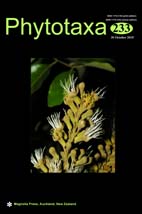Abstract
Marine mammals such as whales and dolphins have been known for a long time to host a very specific epizoic community on their skin. Less known however is the presence of a similar community on the carapaces of sea turtles. The present study is the first describing new taxa inhabiting sea turtle carapaces. Samples, collected from nesting olive ridley sea turtles (Lepidochelys olivacea) on Ostional Beach (Costa Rica), were studied using light and scanning electron microscopy. Two unknown small-celled gomphonemoid taxa were analysed in more detail and are described as two new genera, closely related to other gomphonemoid genera with septate girdle bands, such as Tripterion, Cuneolus and Gomphoseptatum. Chelonicola Majewska, De Stefano & Van de Vijver gen. nov. has a flat valve face, uniseriate striae composed of more than three areolae, simple external raphe endings, internally a siliceous flap over the proximal raphe endings and lives on mucilaginous stalks. Poulinea Majewska, De Stefano & Van de Vijver gen. nov. has at least one concave valve, uniseriate striae composed of only two elongated areolae, external distal raphe endings covered by thickened siliceous flaps and lives attached to the substrate by a mucilaginous pad. Chelonicola costaricensis Majewska, De Stefano & Van de Vijver sp. nov. and Poulinea lepidochelicola Majewska, De Stefano & Van de Vijver sp. nov. can be separated based on stria structure, girdle structure composed of more than 10 copulae, raphe structure and general valve outline. A cladistics analysis of putative members of the Rhoicospheniaceae indicates that the family is polyphyletic. Chelonicola and Poulinea are sister taxa, and form a monophyletic group with Cuneolus and Tripterion, but are not closely related to Rhoicosphenia, or other genera previously assigned to this family. Features used to help diagnose the family such as symmetry and presence of septa and pseudosepta are homoplastic across the raphid diatom tree of life.

